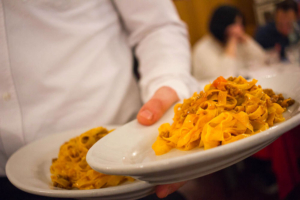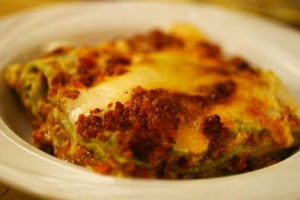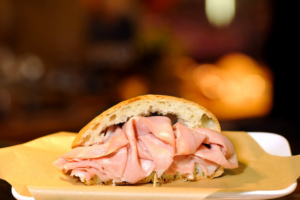Lasagna Bolognese: where locals eat in Bologna
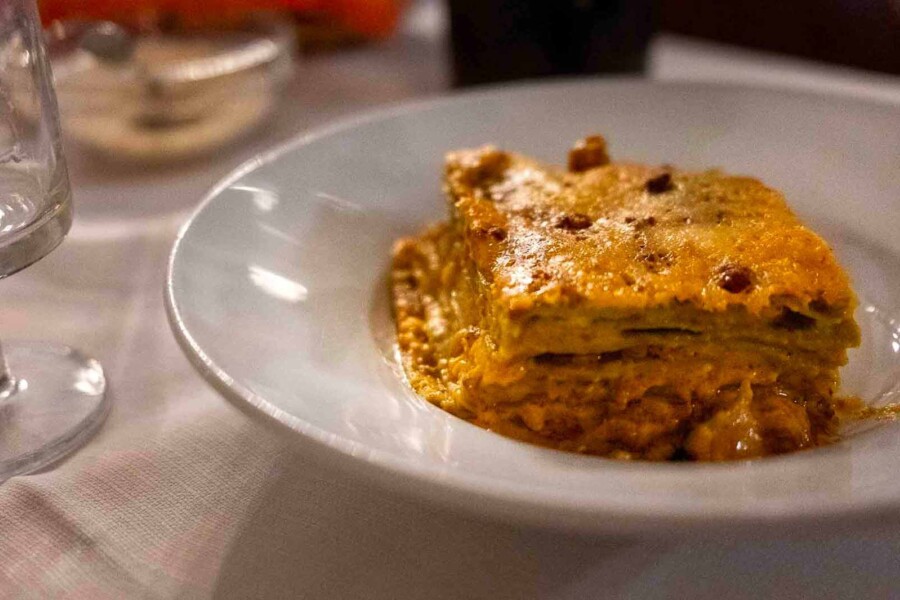
It’s Sunday in Bologna, and the air smells of something slow-cooked, rich, and comforting.
On almost every family table, there’s one dish that never fails to bring people together — lasagna Bolognese.
You might have tried “lasagna” elsewhere, but here, it’s a whole different story. Thinner green pasta sheets, silky béchamel, and a deeply flavored ragù alla bolognese layered with care and patience. Ready to discover where to eat, buy, and truly understand lasagne in Bologna?
Let’s dig in.
In Bologna, you won’t hear locals asking for lasagna — they’ll say lasagne.
The plural form matters.
It’s not just a language quirk; it’s a reflection of the layers themselves.
Each sheet (sfoglia) is rolled by hand, often by a sfoglina — the skilled women who keep the city’s pasta tradition alive. Together, these golden-green sheets become lasagne, each layer essential, none alone.
So yes, lasagna Bolognese and lasagne Bolognese refer to the same dish.
But when in Bologna, using the plural feels just right — as if you’re already part of the tradition.
The story of lasagne stretches far beyond Bologna’s trattorie — it begins in ancient Rome.
Back then, with the Greek laganon and the Latin laganum, people described flat sheets of wheat dough, cut into squares or rectangles, cooked on fire or baked, and layered with meat.
No cheese yet — just the early echoes of what would one day become a legend.
It wasn’t until the 14th century that cheese entered the scene. In the Angevin Court of Naples, a royal cookbook called Liber de Coquina included a version of lasagne made from leavened dough, boiled rather than baked, and enriched with grated cheese.
Centuries later, in 1881, another Neapolitan collection — Il Principe dei Cuochi — marked the first appearance of tomato in the recipe.
The real turning point came in Bologna, in 1863, when Francesco Zambrini published Il libro della cucina del sec. XIV. Here, lasagne appeared a strati — layered — for the first time in printed form, laying the foundation for what we now recognize as lasagne alla bolognese.
But it was Paolo Monelli, in 1935, who crowned Bologna’s version with immortal words. In Il Ghiottone Errante, he wrote:
I have read sacred and profane books, searched a thousand volumes for truth and consolation — yet no book compares to this platter of green lasagne the lively Bolognese innkeepers place before us.
From that moment, the green lasagna Bolognese, made with spinach-infused pasta and rich ragù, became a cultural emblem of the city.
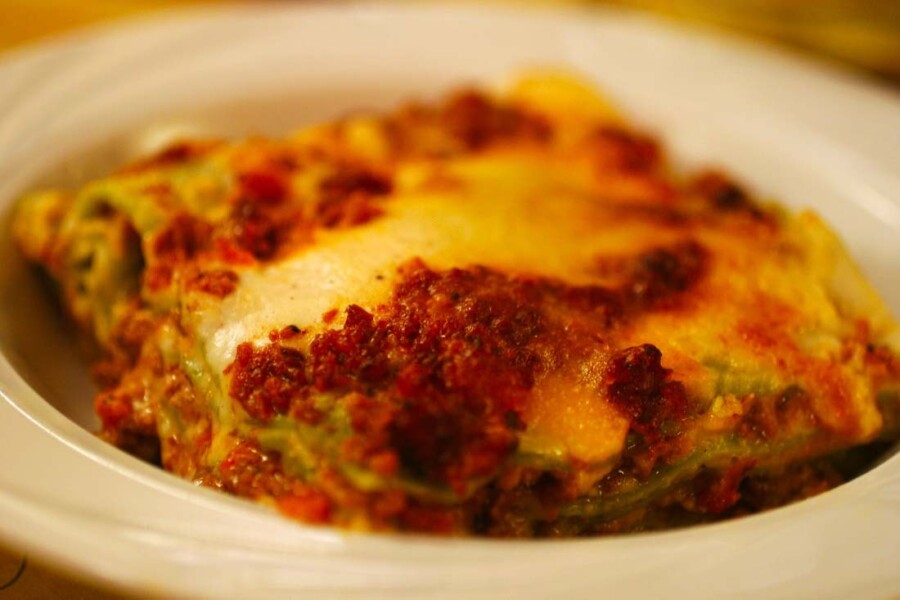
The original Bolognese Recipe
So, what’s in lasagna Bolognese?
The answer is deceptively simple: ragù alla bolognese, béchamel sauce, Parmigiano Reggiano, and green egg pasta sheets — colored with spinach or nettle.
That touch of green doesn’t make it lighter (this is still a rich, complete meal), but it gives a delicate flavor and a beautiful contrast to the deep red sauce.
Ragù alla bolognese isn’t just meat sauce. It’s a slow-cooked symphony of finely chopped soffritto (onion, carrot, celery), minced beef and pork, a touch of tomato paste, and milk — yes, milk — to soften the acidity.
The best meat?
Ground beef and pork, balanced for richness and flavor.
And let’s be clear: you have to use Bolognese sauce to make lasagne. Otherwise, it’s simply not lasagne alla bolognese. There’s no shortcut, no variation — it’s the heart of the dish.
Once the sauces are ready, the layering begins: sfoglia verde, ragù, béchamel, and a generous sprinkle of cheese. Repeat eight or ten times if you want to do it properly.
Bake until the edges bubble and the top turns perfectly golden and crisp — never burnt.
Looking for the best lasagna in Bologna?
Forget tourist menus. Start with these tried-and-true spots.
Trattoria da Me
This family-run spot feels like stepping into a friend’s home.
The lasagne here are made only on Sundays, like the old days.
The sfoglia verde is impossibly thin, the ragù dense and aromatic.
You’ll understand immediately why locals guard their Sunday tables.
Ristorante Al Cambio
A little outside the city center, Al Cambio is worth the short trip. Their lasagna is pure craftsmanship — a layered poem of balance and flavor. The interior mixes old-school elegance with a modern edge, just like their cooking.
Trattoria di Via Serra
Impossible to call, outside the city center, always booked out. But how good is Trattoria di Via Serra's lasagne? Well worth calling a few times or even knocking on the door early to put your fork inside green layers of happiness.
Want to explore beyond lasagne?
Don’t miss our guide to the best pasta in Bologna.
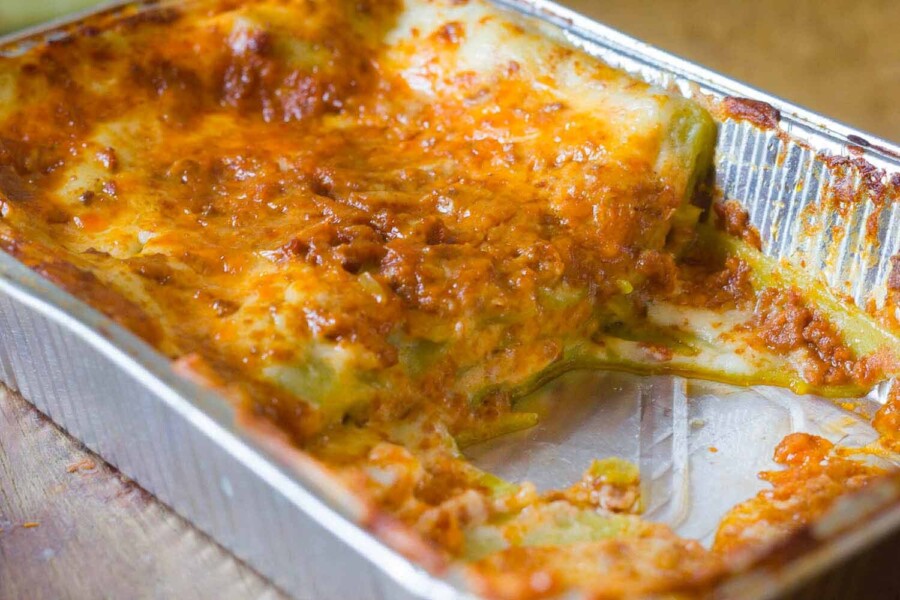
Modena shares the same devotion to lasagne as Bologna — same ingredients, same technique, same love for slow food.
What changes is the atmosphere: a slightly different rhythm, but the same passion on the plate.
Trattoria Aldina
Hidden above a pastry shop, this tiny restaurant is a gem. The lasagne Bolognese here are tall — eight or even ten layers of pure comfort. The ragù clings to every sheet, and the béchamel melts in between like velvet.
Ristorante Da Danilo
In the heart of Modena, Da Danilo is a locals’ favorite — no frills, all substance. On the menu you won’t find “lasagne alla bolognese,” of course.
Here, they’re called lasagne verdi al forno, a small act of civic pride in the friendly rivalry with Bologna.
Yet once you take a bite, you’ll realize they’re speaking the same delicious language — one of patience, skill, and quiet perfection.
Cucina di Quartiere
A newer, more casual spot in Modena. They don’t always have lasagne — if you’re unlucky, go for the passatelli asciutti instead. But when lasagne are on the menu, they’re among the best in the area.
Maybe you want to take a bit of Bologna home.
Or perhaps you’re renting an apartment with a kitchen and can’t resist baking your own. Either way, you’re in the right city.
Start at the Quadrilatero, the oldest Bologna’s food market.
The narrow lanes between Via Drapperie and Via Pescherie Vecchie are filled with delis, bakeries, and pasta shops. The colors, the sounds, the rhythm — it’s sensory overload in the best possible way.
Just a few steps away, in Via Belvedere, you’ll find Le sfogline — the legendary women who roll pasta by hand — crafting sheets of golden-green dough as thin as paper.
Watching them work is hypnotic. During our Bologna Food Tour, you can see them in action, shaping the heart of Bologna’s cuisine.
You can buy pre-assembled lasagne Bolognese to bake at home (even frozen).
Just remember: you’ll need an oven (forno), patience, and a bit of local wine while you wait. When it’s ready, the first forkful will taste like Bologna itself — layer after layer of tradition.
How do you know if you’ve found the real deal?
-
Color: The pasta should be gently green — from spinach or nettle in the dough.
-
Texture: The layers must hold together yet melt in your mouth.
-
Top layer: The sauce on top should be slightly crisp, never burnt — that’s where texture meets flavor.
If all this aligns, you’re not just eating lasagna — you’re tasting centuries of culinary precision.
So now you know what’s in lasagna Bolognese, where to eat it, where to buy it, and even what makes it different from the lasagna you’ve had before.
The next step?
Come to Bologna. Walk through the market, talk to a sfoglina, sit down in a trattoria, and taste for yourself why this city’s most famous dish still rules Italian comfort food.
Because some experiences can’t be explained — they must be baked, layered, and shared, one golden-green sheet at a time.
